The Solar Control Window Films Market is estimated to be valued at USD 1.7 billion in 2025 and is projected to reach USD 4.4 billion by 2035, registering a compound annual growth rate (CAGR) of 9.9% over the forecast period. The market exhibits significant regional growth imbalances driven by variations in regulatory frameworks, construction trends, climate conditions, and energy efficiency initiatives across Asia Pacific, Europe, and North America. Asia-Pacific is poised to dominate the market throughout the forecast period, primarily due to large-scale commercial and residential construction, rapid urban infrastructure expansion, and increasing adoption of energy-efficient building materials.
The region’s growth is further supported by favorable government incentives for green buildings, rising awareness of thermal comfort, and cost-effective labor and material availability, resulting in a faster adoption curve relative to other regions. Europe demonstrates steady growth in the market, with emphasis on high-performance window films for commercial and institutional buildings. Stringent energy efficiency directives, sustainability regulations, and retrofit programs contribute to a moderate yet consistent expansion.
ASPs and adoption rates remain comparatively higher due to advanced technology requirements and established supply chains. North America, while exhibiting growth, lags behind Asia-Pacific in absolute volume due to market saturation in residential and commercial sectors, although rising environmental mandates and retrofit projects provide incremental opportunities. The overall regional imbalance highlights the Asia-Pacific region as the growth engine, Europe as a mature but stable market, and North America as a steady yet slower-growing segment, collectively shaping global market dynamics.

| Metric | Value |
|---|---|
| Solar Control Window Films Market Estimated Value in (2025 E) | USD 1.7 billion |
| Solar Control Window Films Market Forecast Value in (2035 F) | USD 4.4 billion |
| Forecast CAGR (2025 to 2035) | 9.9% |
The solar control window films market is expanding steadily, driven by increasing demand for energy-efficient solutions in the building and automotive sectors. Growing emphasis on reducing energy consumption and improving indoor comfort has fueled the adoption of window films that reduce heat gain and glare.
Industry trends highlight the growing use of solar control films in new construction and retrofit projects as sustainability standards and building codes tighten globally. Advances in film technology have improved the durability and performance of solar control films, making them more appealing to architects and building owners.
Additionally, rising awareness about UV protection and occupant health has contributed to market growth. The shift towards green buildings and government incentives for energy-efficient materials are expected to support continued expansion. Segment growth is expected to be led by vacuum coated reflective films due to their superior heat rejection properties, construction applications reflecting large-scale adoption, and metallic absorbers for their effective solar energy absorption.
The solar control window films market is segmented by type, application, absorber, and geographic regions. By type, the solar control window films market is categorized into Vacuum Coated (Reflective), Clear (Non-Reflective), Dyed (Non-Reflective), High-Performance Film, and Others. In terms of application, the solar control window films market is classified into Construction, Automotive, Marine, Graphics/Decorative, and Others.
Based on the absorber, the solar control window films market is segmented into Metallic, Organic, and Inorganic Ceramic. Regionally, the solar control window films industry is classified into North America, Latin America, Western Europe, Eastern Europe, Balkan & Baltic Countries, Russia & Belarus, Central Asia, East Asia, South Asia & Pacific, and the Middle East & Africa.
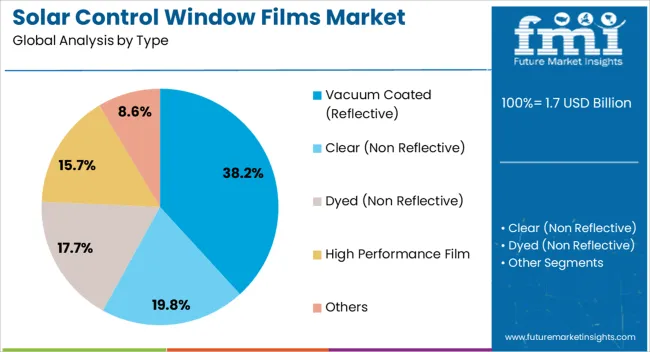
The Vacuum Coated (Reflective) segment is expected to hold 38.2% of the solar control window films market revenue in 2025, retaining its position as the leading type category. This segment benefits from its ability to reflect a significant portion of solar radiation, reducing indoor heat and lowering cooling costs.
These films offer high optical clarity combined with strong solar control performance, making them a preferred choice for commercial and residential buildings. Enhanced durability and scratch resistance of vacuum-coated films have increased their lifespan and reduced maintenance needs.
Furthermore, architects and designers favor these films for their sleek appearance and ability to complement modern building aesthetics. With a continued focus on energy savings and occupant comfort, vacuum-coated reflective films are expected to maintain their market leadership.

The Construction segment is projected to account for 44.7% of the market revenue in 2025, maintaining its dominance as the primary application area. This growth is driven by rising investments in commercial and residential building projects emphasizing energy efficiency and sustainability.
Window films are increasingly integrated into building envelopes to meet regulatory requirements and green building certifications. The demand for retrofit installations to improve the energy performance of existing buildings has also grown substantially.
Building owners and facility managers value solar control films for their ability to reduce glare and UV damage while improving occupant comfort. As urbanization and infrastructure development accelerate, the Construction segment is poised to continue leading demand in the solar control window films market.
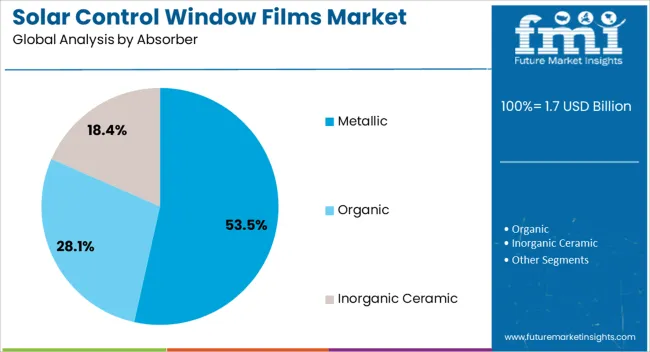
The Metallic absorber segment is projected to hold 53.5% of the market revenue in 2025, establishing itself as the dominant absorber type. Metallic absorbers are favored for their excellent solar energy absorption and heat reduction capabilities, making them effective in minimizing cooling loads.
The reflective properties of metallic films contribute to glare reduction and improved visual comfort indoors. Additionally, metallic absorbers offer robust performance in diverse climatic conditions and have been widely adopted in both new and retrofit applications.
Manufacturers have improved coating techniques to enhance the durability and optical clarity of metallic absorber films. With a continued focus on energy efficiency and occupant wellbeing, the metallic absorber segment is expected to retain its leading position.
The solar control window films market has been expanding due to growing demand for energy-efficient and glare-reducing solutions in residential, commercial, and automotive applications. These films have been widely applied to minimize heat gain, improve indoor comfort, and reduce cooling costs. Market growth has been supported by advances in spectrally selective coatings, nano-material technologies, and durable adhesive layers.
Increasing awareness of energy conservation, government energy efficiency programs, and the rising adoption of green building practices have further strengthened the deployment of solar control window films globally.
The rising need to reduce energy consumption in residential and commercial buildings has been a key driver of the solar control window films market. These films have been applied to windows and glass facades to minimize heat penetration, reduce glare, and improve thermal insulation, which in turn lowers reliance on air conditioning systems. Advanced technologies, including low-emissivity coatings and spectrally selective films, have enhanced performance while maintaining visibility and natural light transmission.
Architects and building developers have increasingly preferred these films as retrofitting solutions to improve energy efficiency in existing structures. Incentives, energy codes, and sustainability certifications such as LEED and BREEAM have encouraged adoption, making solar control window films an integral component of energy-conscious building design worldwide.
Technological advancements have improved the functionality, durability, and aesthetic appeal of solar control window films. Nano-ceramic coatings, infrared-blocking layers, and UV-resistant materials have enhanced thermal control, glare reduction, and protection against harmful rays. Films with self-cleaning, anti-reflective, and anti-scratch properties have been developed to enhance longevity and reduce maintenance requirements. Innovations in multi-layered and spectrally selective designs have allowed high solar energy rejection without compromising visible light transmission.
Integration with smart window systems and electrochromic technologies has further expanded functionality in modern buildings and automotive glazing. These technological improvements have increased efficiency, performance consistency, and overall market acceptance of solar control window films across diverse applications globally.
Compliance with energy efficiency and environmental regulations has been a major factor driving the adoption of solar control window films. Governments and local authorities have established energy performance standards for buildings, promoting the use of glazing solutions that reduce heat gain and lower carbon emissions.
Certifications and labeling programs, including Energy Star ratings and green building certifications, have allowed end users to select effective solar control films based on performance metrics. Solar control films have also contributed to achieving sustainability goals by reducing energy consumption and greenhouse gas emissions.
Regulatory frameworks, combined with growing environmental awareness, have reinforced the integration of these films into both new constructions and retrofitting projects in the residential, commercial, and automotive sectors worldwide.
The increasing adoption of smart buildings, connected infrastructure, and automotive glazing solutions has created new opportunities for the solar control window films market. Films have been applied in smart office spaces, high-rise residential units, and automotive windshields to improve energy management, occupant comfort, and UV protection.
Integration with automated shading systems, energy monitoring platforms, and electrochromic windows has enhanced operational control and energy savings. Rising automotive production and the demand for premium sun protection features have also supported market growth. As energy efficiency and sustainability continue to gain importance in construction and vehicle design, solar control window films are expected to experience expanded adoption globally, offering both functional and environmental benefits.
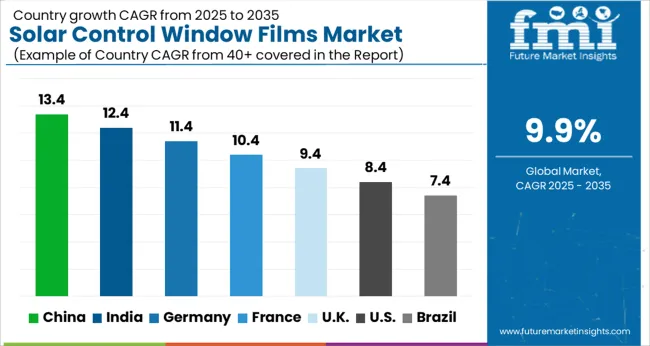
The market is projected to expand at a CAGR of 9.9% between 2025 and 2035, supported by rising energy efficiency demands in commercial and residential buildings, and increasing awareness of UV protection and thermal insulation. China leads with a 13.4% CAGR, driven by rapid urban construction and government energy regulations. India follows at 12.4%, with growth fueled by expanding real estate development and sustainability initiatives. Germany, at 11.4%, benefits from stringent building codes and energy-saving policies. The UK, growing at 9.4%, emphasizes energy-efficient building retrofits, while the USA, at 8.4%, experiences steady adoption through commercial and residential modernization projects. This report includes insights on 40+ countries; the top markets are shown here for reference.
China is expected to expand at a CAGR of 13.4% from 2025 to 2035 in the solar control window films industry, driven by increasing adoption in commercial and residential buildings. Manufacturers are introducing high-performance coatings that enhance thermal insulation while maintaining visible light transmittance. Collaborations with construction companies and window fabricators have accelerated market penetration, while government programs promoting energy-efficient infrastructure have boosted demand. The competitive landscape is dominated by global players and domestic brands focusing on innovation and cost optimization. Advanced production techniques and coatings with long service life have strengthened China’s position as a key market.
The solar control window films industry in India is projected to grow at a CAGR of 12.4% during 2025 to 2035, supported by increasing demand for energy-efficient glazing in commercial and residential properties. Adoption is particularly high in metropolitan areas due to rising cooling requirements and regulatory incentives. Collaborations between film manufacturers and glass producers have accelerated market expansion. Innovative coatings improving UV protection and heat rejection are driving product differentiation. Demand from corporate offices, retail centers, and hospitals has strengthened growth prospects.
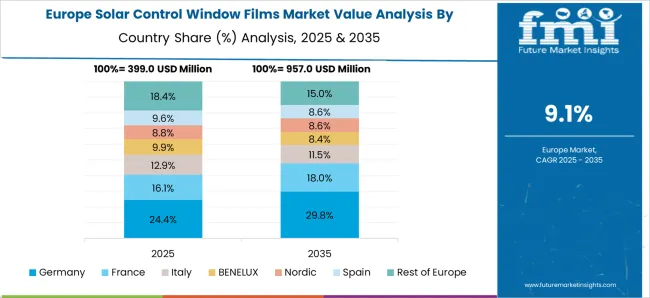
Sales of solar control window films in Germany are anticipated to grow at a CAGR of 11.4% from 2025 to 2035, fueled by strict energy efficiency regulations in residential and commercial buildings. Premium glazing solutions with low-emissivity coatings are increasingly adopted, and collaborations with glass manufacturers have facilitated product integration. Market demand is concentrated in office complexes, hospitals, and educational institutions. Environmental initiatives promoting reduced energy consumption in buildings are further stimulating growth. Key players focus on innovation in coatings, service life extension, and performance consistency.
The solar control window films industry in the United Kingdom is expected to progress at a CAGR of 9.4% from 2025 to 2035, driven by increased demand in commercial offices, healthcare facilities, and educational institutions. Thermal performance and UV protection features are highly valued. Local regulations for energy reduction have encouraged adoption in both new constructions and retrofits. Technological advancements in nano-coatings have further improved market penetration. The competitive environment is marked by a mix of domestic brands and international suppliers.
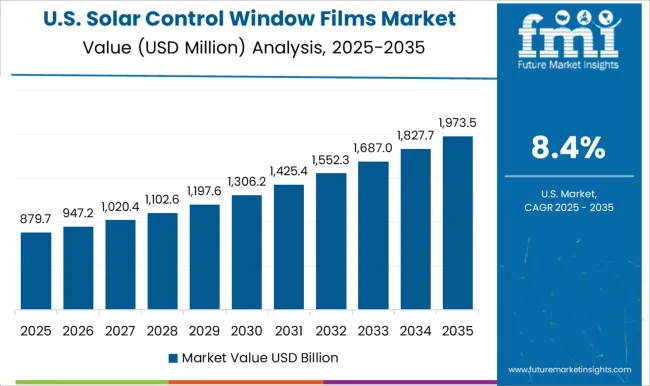
Sales of solar control window films in the United States are forecast to expand at a CAGR of 8.4% between 2025 and 2035, driven by commercial buildings and energy efficiency initiatives. Adoption is higher in states with extreme temperature ranges where solar heat reduction is critical. Partnerships with window manufacturers and distributors have facilitated wider product availability. Advanced coatings offering glare reduction and UV protection are preferred by office buildings and retail spaces. The market is influenced by increasing awareness of energy savings and regulatory incentives promoting efficient building design.
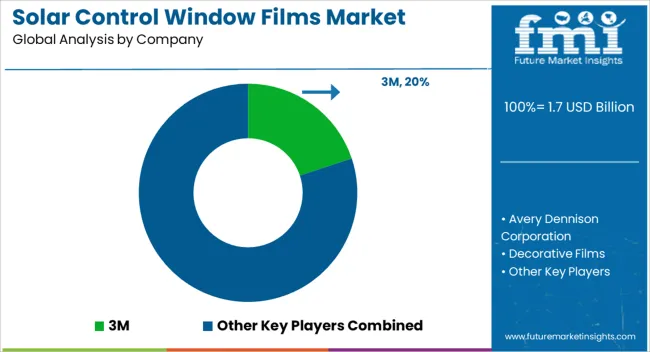
3M leads the market with a broad portfolio of high-performance films offering UV protection, glare reduction, and heat rejection, combined with advanced adhesive technologies.
Avery Dennison Corporation focuses on innovative designs and functional films tailored for architectural and automotive segments, while Decorative Films and Deposition Technology Innovations provide customized solutions for aesthetic and performance-based requirements.
Eastman Performance Films and Dexerials Corporation deliver advanced coatings and multi-layered films to improve thermal insulation and durability. Garware Suncontrol Film, Johnson Window Films, and Lintec Corporation specialize in high-quality, scratch-resistant films suitable for long-term applications in challenging climates. Madico, Nexfil, NDFOS, and Polytronix emphasize UV and infrared rejection technologies to enhance energy savings and interior comfort.
Saint-Gobain Performance Plastics, Sunsational Solutions, and XPEL integrate innovative nanotechnology and advanced polymer structures to improve optical clarity and film longevity. Key strategies in the market include product launches, research and development for higher heat rejection, partnerships with glass manufacturers, and expansion into emerging regions. Entry barriers include the need for technical expertise, regulatory compliance, and investment in R&D. Companies that combine performance, aesthetics, and durability are best positioned to capture market share in this evolving sector.
| Item | Value |
|---|---|
| Quantitative Units | USD 1.7 Billion |
| Type | Vacuum Coated (Reflective), Clear (Non Reflective), Dyed (Non Reflective), High Performance Film, and Others |
| Application | Construction, Automotive, Marine, Graphics/Decorative, and Others |
| Absorber | Metallic, Organic, and Inorganic Ceramic |
| Regions Covered | North America, Europe, Asia-Pacific, Latin America, Middle East & Africa |
| Country Covered | United States, Canada, Germany, France, United Kingdom, China, Japan, India, Brazil, South Africa |
| Key Companies Profiled | 3M, Avery Dennison Corporation, Decorative Films, Deposition Technology Innovations, Dexerials Corporation, Eastman Performance Films, Garware Suncontrol Film, Johnson Window Films, Lintec Corporation, Madico, Nexfil, NDFOS, Polytronix, Saint-Gobain Performance Plastics, Sunsational Solutions, and XPEL |
| Additional Attributes | Dollar sales by film type and end-use application, demand dynamics across residential, commercial, and automotive sectors, regional trends in adoption across North America, Europe, and Asia-Pacific, innovation in heat rejection coatings, UV protection layers, and smart tinting technologies, environmental impact of energy savings, reduced air conditioning load, and material recyclability, and emerging use cases in retrofit energy efficiency, glare reduction in high-rise buildings, and automotive cabin comfort enhancement. |
The global solar control window films market is estimated to be valued at USD 1.7 billion in 2025.
The market size for the solar control window films market is projected to reach USD 4.4 billion by 2035.
The solar control window films market is expected to grow at a 9.9% CAGR between 2025 and 2035.
The key product types in solar control window films market are vacuum coated (reflective), clear (non reflective), dyed (non reflective), high performance film and others.
In terms of application, construction segment to command 44.7% share in the solar control window films market in 2025.






Our Research Products

The "Full Research Suite" delivers actionable market intel, deep dives on markets or technologies, so clients act faster, cut risk, and unlock growth.

The Leaderboard benchmarks and ranks top vendors, classifying them as Established Leaders, Leading Challengers, or Disruptors & Challengers.

Locates where complements amplify value and substitutes erode it, forecasting net impact by horizon

We deliver granular, decision-grade intel: market sizing, 5-year forecasts, pricing, adoption, usage, revenue, and operational KPIs—plus competitor tracking, regulation, and value chains—across 60 countries broadly.

Spot the shifts before they hit your P&L. We track inflection points, adoption curves, pricing moves, and ecosystem plays to show where demand is heading, why it is changing, and what to do next across high-growth markets and disruptive tech

Real-time reads of user behavior. We track shifting priorities, perceptions of today’s and next-gen services, and provider experience, then pace how fast tech moves from trial to adoption, blending buyer, consumer, and channel inputs with social signals (#WhySwitch, #UX).

Partner with our analyst team to build a custom report designed around your business priorities. From analysing market trends to assessing competitors or crafting bespoke datasets, we tailor insights to your needs.
Supplier Intelligence
Discovery & Profiling
Capacity & Footprint
Performance & Risk
Compliance & Governance
Commercial Readiness
Who Supplies Whom
Scorecards & Shortlists
Playbooks & Docs
Category Intelligence
Definition & Scope
Demand & Use Cases
Cost Drivers
Market Structure
Supply Chain Map
Trade & Policy
Operating Norms
Deliverables
Buyer Intelligence
Account Basics
Spend & Scope
Procurement Model
Vendor Requirements
Terms & Policies
Entry Strategy
Pain Points & Triggers
Outputs
Pricing Analysis
Benchmarks
Trends
Should-Cost
Indexation
Landed Cost
Commercial Terms
Deliverables
Brand Analysis
Positioning & Value Prop
Share & Presence
Customer Evidence
Go-to-Market
Digital & Reputation
Compliance & Trust
KPIs & Gaps
Outputs
Full Research Suite comprises of:
Market outlook & trends analysis
Interviews & case studies
Strategic recommendations
Vendor profiles & capabilities analysis
5-year forecasts
8 regions and 60+ country-level data splits
Market segment data splits
12 months of continuous data updates
DELIVERED AS:
PDF EXCEL ONLINE
Solar Charge Controller Market Growth – Trends & Forecast 2022-2032
Sun Control Films Market Size and Share Forecast Outlook 2025 to 2035
Market Share Breakdown of Sun Control Films Manufacturers
MPPT Solar Charge Controllers for Off-Grid Market Size and Share Forecast Outlook 2025 to 2035
Control Network Modules Market Size and Share Forecast Outlook 2025 to 2035
Solar Module Recycling Service Market Size and Share Forecast Outlook 2025 to 2035
Solar Tracking Module Market Size and Share Forecast Outlook 2025 to 2035
Controllable Shunt Reactor for UHV Market Size and Share Forecast Outlook 2025 to 2035
Window Air Conditioner Market Size and Share Forecast Outlook 2025 to 2035
Solar Analyzer Market Size and Share Forecast Outlook 2025 to 2035
Control Room Solution Market Size and Share Forecast Outlook 2025 to 2035
Solar Aluminum Alloy Frame Market Size and Share Forecast Outlook 2025 to 2035
Solar Grade Monocrystalline Silicon Rods Market Analysis - Size, Share, and Forecast Outlook 2025 to 2035
Control Knobs for Panel Potentiometer Market Size and Share Forecast Outlook 2025 to 2035
Controlled-Release Drug Delivery Technology Market Size and Share Forecast Outlook 2025 to 2035
Solar Vehicle Market Size and Share Forecast Outlook 2025 to 2035
Solar PV Module Market Size and Share Forecast Outlook 2025 to 2035
Solar Encapsulation Market Size and Share Forecast Outlook 2025 to 2035
Solar Pumps Market Analysis - Size, Share, and Forecast Outlook 2025 to 2035
Solar Mobile Light Tower Market Size and Share Forecast Outlook 2025 to 2035

Thank you!
You will receive an email from our Business Development Manager. Please be sure to check your SPAM/JUNK folder too.
Chat With
MaRIA